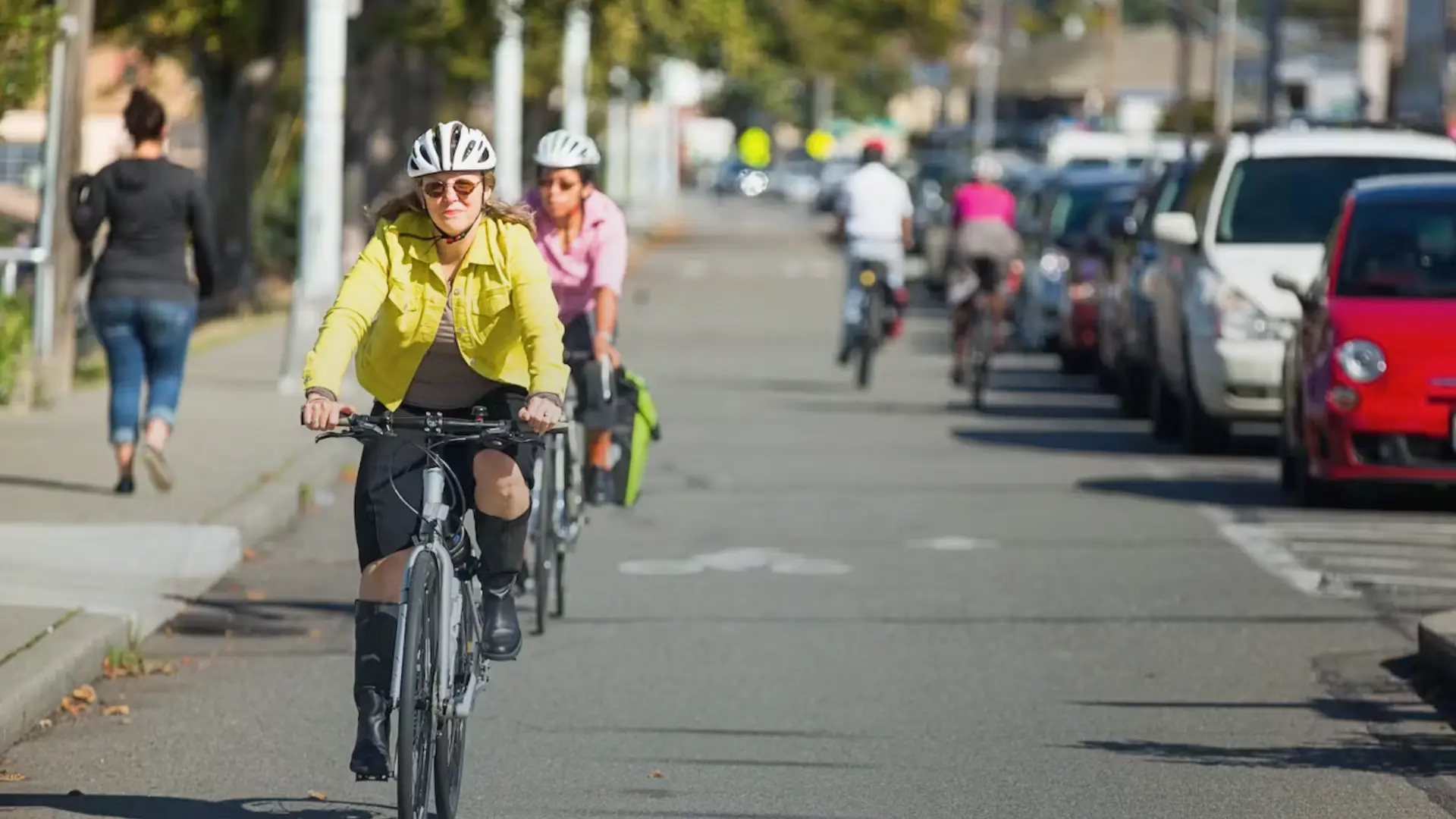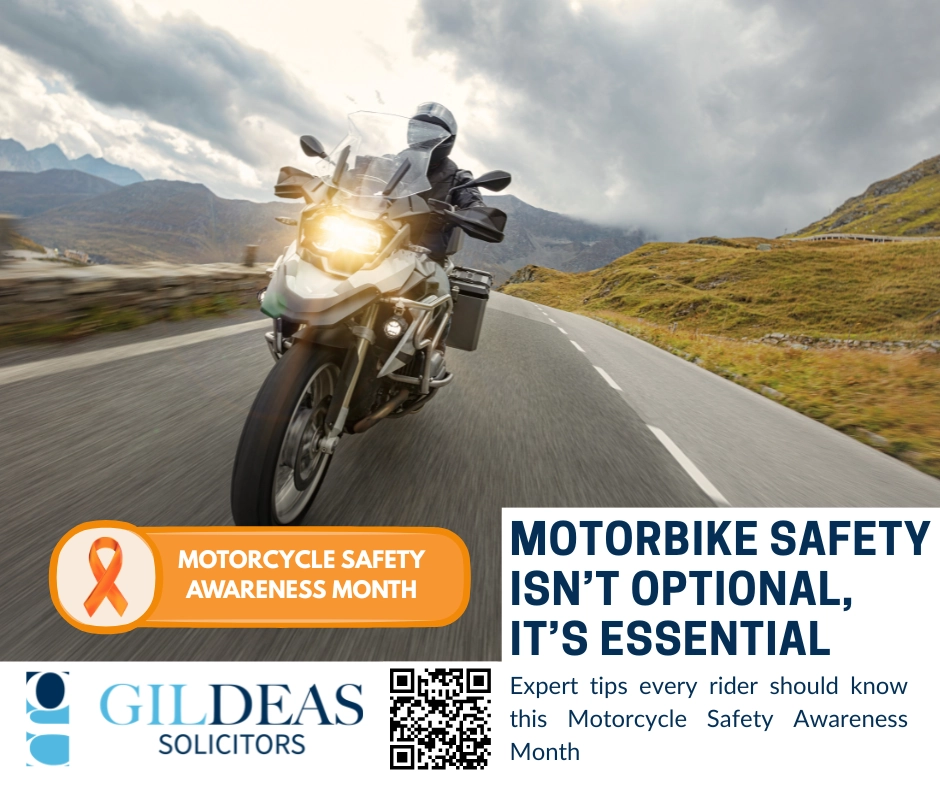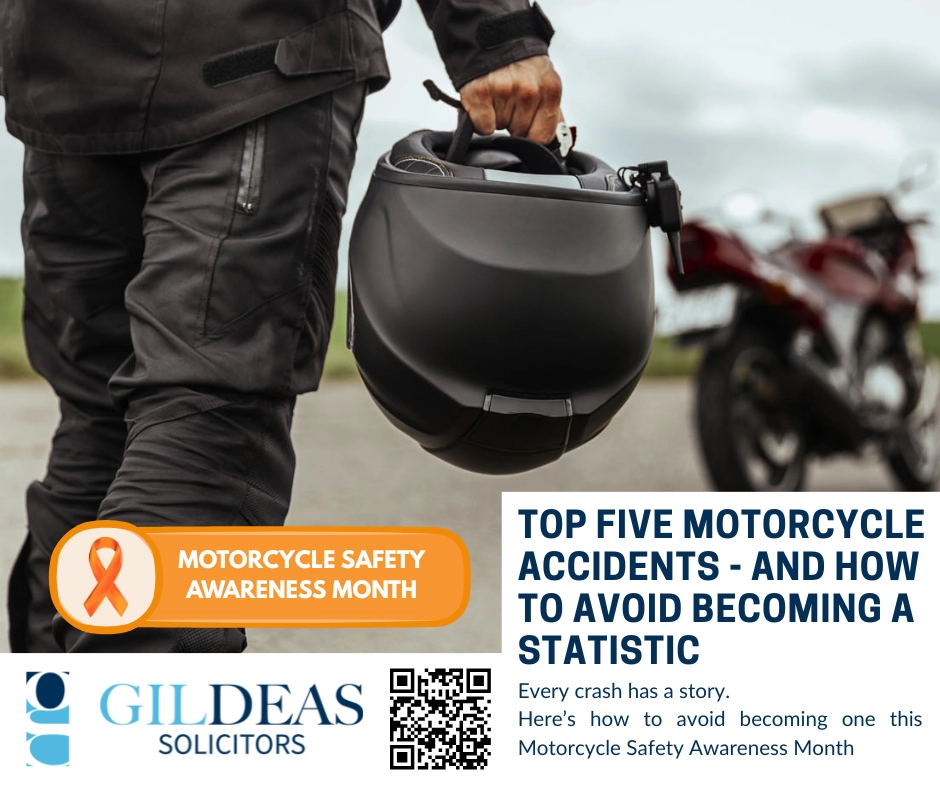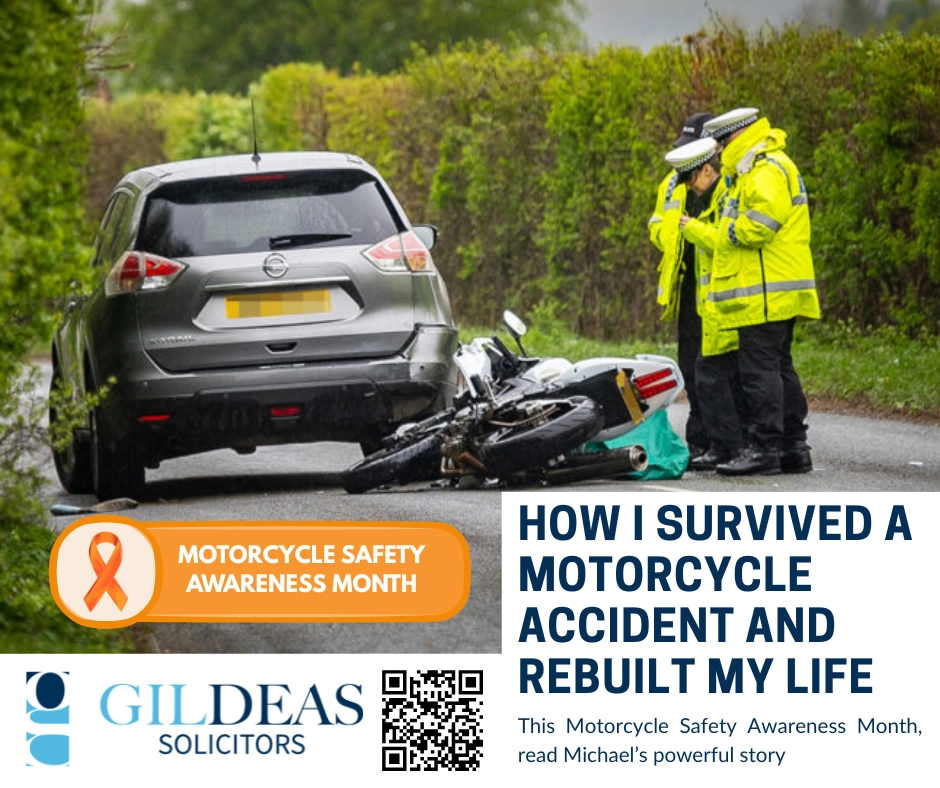World Bicycle Day: Time For A Truce?
- Home
- Archive by Category "Personal injury" (
- Page 2 )
Share this article
Each year, World Bicycle Day gives us the chance to celebrate the many benefits of cycling – from improved health and reduced congestion to cleaner air and more liveable cities. But it’s also a moment to reflect on how we can foster better relationships between cyclists and other road users.
In 2025, that reflection is more important than ever.
Scottish Road Safety Data reported that from 2018 – 2022, there were 2,850 casualties from accidents involving cyclists.
Despite recent updates to the Highway Code, the roads are still fraught with confusion, frustration, and sadly, too often, conflict. The key to improving safety and harmony on our roads lies in mutual respect, education, and legal reform – supported by a clear understanding of the rights and responsibilities we all share.
Understanding Each Other’s Perspective
As ultra-cyclist Mark Beaumont recently noted in a radio interview, much of the current discourse around road safety is unhelpfully divisive. Cyclists using cameras to document close passes and dangerous driving is understandable – and in many cases vital for evidence. But when these clips are posted online, they can sometimes fan the flames of animosity rather than encourage change.
He asked an important question: “Do you just post hate and take a stance, or are you actually addressing the information?” His point is a crucial one. Whether behind the wheel or the handlebars, we must prioritise constructive conversations over condemnation. Most cyclists also drive. Many drivers cycle. We all want safe roads for ourselves, our families, and our communities.
The Highway Code: More Than Just Rules
The 2022 revisions to the Highway Code introduced a hierarchy of road users, placing the greatest responsibility on those with the potential to do the most harm. This includes crucial guidance on safe overtaking distances, giving way to pedestrians at junctions, and allowing cyclists to ride in the centre of a lane when it is safer to do so.
Yet public awareness of these changes remains dangerously low. A recent report co-commissioned by the Bikeability Trust revealed that only 70% of drivers believe that ‘cyclists have equal rights on the road as drivers’. This lack of understanding creates tension and confusion on the roads – and leaves vulnerable road users at increased risk.
Why We Need Presumed Liability
Chris Boardman, Olympic champion and cycling policy advisor, is one of many advocates petitioning for the UK to introduce presumed liability in civil law – a system already in place in many European countries. Under such a system, when a crash occurs between a driver and a cyclist, the motorist is presumed to be at fault unless proven otherwise.
Presumed liability helps reflect the principle of causative potency – the legal recognition that motor vehicles have a far greater potential to cause harm than bicycles or pedestrians.
It’s important to note – this doesn’t mean motorists are always to blame, but rather that the responsibility to take extra care lies more heavily with those operating heavier and faster vehicles.
Real-life cases show how the courts already account for this. In a collision between an HGV and a cyclist, for example, the driver was found to be 70 per cent responsible despite the cyclist’s own actions contributing to the crash. The rationale? The sheer size and danger of the vehicle meant the consequences of a mistake were far more severe.
Introducing presumed liability in law would reinforce this principle, make it easier for injured cyclists to seek justice, and encourage all drivers to adopt a more cautious approach around vulnerable road users.
Cultivating Safer Roads Through Empathy and Action
So how do we create safer, more harmonious roads?
The answer lies partly in education – not just for cyclists, but for all road users. There is still widespread misunderstanding about why cyclists take the lane, filter through traffic, or choose not to use poorly designed cycle lanes. Meanwhile, myths like “cyclists don’t pay for roads” continue to sow division.
We must also be willing to look beyond individual behaviour and towards systemic change. The upcoming Government Road Safety Strategy offers a golden opportunity to invest in safer infrastructure, introduce presumed liability, and promote better driver training.
Here are a few essential reminders for road users:
- Give space: Highway Code Rule 163 recommends giving cyclists the same passing room as a car – ideally at least 1.5 metres.
- Respect positioning: Cyclists often ride away from the kerb or even in the centre of the lane for safety, not stubbornness.
- Communicate clearly: Signal your intentions, check mirrors, and be mindful of cyclists filtering through traffic or approaching from behind.
- Stay calm: Most ‘anger’ from cyclists is fear – a natural reaction when one’s physical safety is at risk.
- Avoid assumptions: Just as not all drivers speed, not all cyclists jump red lights. Let’s avoid generalisations and focus on courtesy.
How Gildeas Solicitors Can Help
At Gildeas Solicitors, we understand the vulnerability cyclists face on the roads. Our specialist personal injury team has extensive experience helping injured cyclists seek compensation and justice after road traffic accidents.
We take into account the principle of causative potency when evaluating cases and are proud to support efforts to make the roads safer for everyone. If you’ve been injured while cycling, we’re here to help you understand your rights and explore your options for a claim.
We believe in roads that work for everyone – where children can ride safely to school, commuters can cycle to work confidently, and all road users can travel harmoniously.
Contact us today for expert legal advice and support if you or a loved one has been involved in a cycling accident.
Celebrate World Bicycle Day with peace of mind, knowing that if an accident occurs, you have a dedicated team ready to support you.
Gildeas Solicitors is a recognised law firm specialising in personal injury claims, supporting you throughout Scotland from our offices in Glasgow and Edinburgh. We’re passionate about what we do, whilst putting our clients’ interests first. That’s why we make personal injury personal.
Considering our services? Call our dedicated team today on 0141 331 6070. </span</p
More to explore
Motorcycle Safety Isn’t Optional, It’s Essential: Expert Tips Every Rider Should Know
- Home
- Archive by Category "Personal injury" (
- Page 2 )
Share this article
Starting your journey as a motorcyclist is exciting. Whether you’ve just completed your CBT or a seasoned rider after some time away, May’s Motorcycle Safety Awareness Month is the perfect time to refresh your knowledge and prioritise safety.
At Gildeas Solicitors, we have experienced motorcycle riders within our legal team. We understand that keeping good habits and having up to date knowledge can prevent injuries and even save lives.
Owning a motorbike offers freedom and enjoyment, but it also requires some responsibility. Riders are far more exposed than car drivers and often less visible on the road, so being prepared and well informed can reduce the risk and ensure you enjoy each journey to the fullest.
Keep reading for our must-know safety tips every rider should follow.
Take Training Seriously
The Compulsory Basic Training (CBT) course is just the beginning. For those looking to build confidence and skill, further training can be invaluable.
RoSPA and other trusted providers offer advanced riding courses which teach you to handle different road conditions, assess hazards, and make safer decisions. These courses are especially useful if it’s been some time since you completed your CBT, or you’re returning to riding after an extended break.
Tip: Consider booking an advanced training session each year. It keeps your skills sharp and gives you more control on the road.
Prioritise Visibility
Many motorbike accidents happen because drivers simply don’t see the rider. Visibility should be one of your top priorities every time you ride.
To mitigate this, choose to wear bright or reflective clothing, especially when riding at night or in low light. Use dipped headlights even during the day to make yourself more noticeable. Fluorescent jackets, reflective tape and high visibility helmets can all improve how easily other drivers see you.
Tip: Don’t assume drivers have seen you. Make eye contact where possible and always position yourself to stay out of blind spots.
Invest in the Right Safety Gear
Investing in the right gear does more than meet legal requirements. It can reduce injuries, make riding more comfortable, and give you added confidence on the road.
Safety isn’t a luxury; it’s an absolute necessity. Always wear a high-quality helmet that meets British safety standards. Choose gear with built in armour for your shoulders, elbows, knees and back. Boots and gloves designed for motorcycling are also essential for protection and grip.
Visiting a dedicated motorcycle shop where trained staff can help with fit and recommendations can make all the difference.
Tip: Buying gear that’s AAA certified can give you added peace of mind. With AAA certification, this signifies the clothing has met or exceeded rigorous standards set by industry experts and organisations, such as material quality, impact protection, abrasion resistance, and ergonomic design.
Check Your Bike Regularly
Routine maintenance is essential for staying safe on the road. Before each ride, check your brakes, lights, oil, tyre pressure and chain tension. All of this can be done whilst you’re warming the engine, as you should always let the oil flow around the engine before moving off. If anything feels off, don’t ignore it.
Schedule regular servicing by a qualified mechanic and keep a record of your maintenance history. This can also support your case in the event of an accident.
Tip: Simple checks that take a few minutes can make a massive difference to your safety. Follow the BOLTS system for quick checks:
Brakes – Check both front and rear brakes before setting off.
Oil – Check the oil level on your bike with the dipstick or through the sight glass.
Lights – Check the lights work properly. Do you have any panel lights out? Do you have a spare for the headlight or tail light? Both are easy to replace, and we advise to carry spares.
Tyres – Check the tyre pressure according to the manual, but a ballpark figure of about 30psi is often normal. Check the tread depth, and if there are any splits or nails.
Steering – Check that the steering moves freely side to side, that there are no cables hindering it, and that it doesn’t feel loose or notchy as this indicates bearing wear.
Suspension – Put some weight on the front and then the back, see the suspension moving properly and then check there is no oil around where the shiny shaft goes into the seal.
Ride Defensively
Many road users won’t anticipate your movements or understand how quickly a motorbike can accelerate. Always ride as if others can’t see you or may make sudden decisions.
Maintain a safe following distance and avoid weaving through traffic. Be cautious at junctions and roundabouts, where many accidents involving motorcycles occur.
Tip: Watch for clues from other vehicles, such as wheels beginning to turn or drivers shifting in their seats. These signs can help you anticipate their next move.
Understand the Road Conditions
Scotland’s roads can be unpredictable. From potholes and loose gravel to changing weather and sharp bends or country roads, riders unfortunately need to stay alert at all times.
To mitigate this, ensure you leave plenty of time to slow down in wet or icy conditions and avoid sudden braking. Rural roads, especially in the Highlands and Borders, may have blind corners or livestock crossings, so take extra care.
Tip: Always adjust your speed and riding style based on road and weather conditions, not just the speed limit.
Know Your Legal Rights
Even with the best preparation, accidents can still happen. If they do, knowing your rights is crucial.
At Gildeas Solicitors, we specialise in supporting motorcyclists following accidents. We can help you understand whether you are entitled to compensation and guide you through the legal process with dedication, compassion, and experience.
Conclusion
Starting out on two wheels can be one of the most rewarding decisions you make, but it comes with responsibility. Motorcycle Safety Awareness Month is a time to commit to good habits, proper equipment, and ongoing training.
The more you invest in your safety now, the more confident and prepared you’ll be – whatever the road brings.
Need Legal Advice After a Motorbike Accident?
If you or someone you know has been involved in a motorcycle accident, contact Gildeas Solicitors today. We offer expert legal advice tailored to riders and can help you get the compensation and support you deserve.
Gildeas Solicitors is a recognised law firm specialising in personal injury claims, supporting you throughout Scotland from our offices in Glasgow and Edinburgh. We’re passionate about what we do, whilst putting our clients’ interests first. That’s why we make personal injury personal.
Considering our services? Call our dedicated team today on 0141 331 6070.
What the Law Says About Motorbike Safety in 2025 - And Why It Matters
Riding a motorbike offers a sense of freedom and control that few other modes of transport can match. But with that freedom comes risk, especially in Scotland, where winding roads, unpredictable weather and rural traffic all present unique challenges for riders.
Motorbike Safety Awareness Month 2025 serves as a reminder not only to check your bike and riding habits but also to understand how the law is evolving to protect you. From tougher penalties for careless drivers to new legal protections for vulnerable road users, the landscape is changing.
In this blog, Gildeas Solicitors outlines what every motorcyclist in Scotland needs to know about recent and upcoming legal changes and how they can affect your rights and motorbike safety on the road.
Stronger Penalties For Dangerous Driving
In response to growing concern over road safety, the courts now have greater sentencing powers. Drivers who cause death by dangerous driving can face life imprisonment. Serious injury by careless or dangerous driving now carries heavier penalties than ever before.
Why it matter for bikers:
Motorcyclists are among the most vulnerable road users. When a crash is caused by someone else’s recklessness, it is vital that the law delivers justice. These tougher penalties reflect the seriousness of the consequences for bikers and their families.
Highway Code Updates Offer More Protection
The 2022 update to the Highway Code introduced a hierarchy of road users. This places a higher level of responsibility on those operating larger and potentially more dangerous vehicles.
Motorcyclists, along with cyclists and pedestrians, are now considered priority users. Drivers are required to give greater space when overtaking and must give way to motorcyclists at junctions.
Why it matters for bikers:
These changes are aimed at reducing the number of common accidents involving motorcyclists. However, they rely on other drivers knowing and respecting the rules.
If you are injured because someone ignored them, you may be entitled to make a claim.
Focus On Advanced Rider Training
While Compulsory Basic Training (CBT) remains the legal entry point for riding, there is increasing encouragement for motorcyclists to undergo further training.
Police Scotland continues to promote Rider Refinement courses, especially in areas with high collision rates such as the Highlands, Argyll and Bute, and the Borders. Refresher training is also recommended for returning riders, particularly those over 35.
Why it matters for bikers:
Ongoing training not only makes you safer but can also help support your case in the event of a crash. It demonstrates responsible riding and reduces the risk of fault being unfairly assigned to you.
Use of Camera Footage in Legal Claims
Helmet cameras and dashcams are becoming standard equipment for many riders, and for good reason. The footage is increasingly accepted in Scottish courts as valid evidence in both criminal and civil cases.
Why it matters for bikers:
Video footage can make all the difference when liability is disputed. At Gildeas, we work with clients to gather and present this type of evidence effectively, helping to build a stronger case.
Debate Around Presumed Liability
While not yet in effect, there is growing support across the UK for a presumed liability system. This would place the responsibility on drivers to prove they were not at fault when colliding with a vulnerable road user such as a motorcyclist.
Similar laws exist in several European countries and are designed to improve safety by increasing driver awareness.
Why it matters for bikers:
Although still under discussion, the introduction of such a policy would significantly strengthen a motorcyclist’s legal position in the aftermath of an accident.
Gildeas Solicitors - Legal Support That Understands Riders
At Gildeas, we understand the challenges that bikers face both on the road and in the legal system. If you are injured in a motorcycle accident, it is important to work with a legal team that not only understands the law but also understands motorcycling.
We can help with:
- Access to medical experts and rehabilitation specialists
- Coordination of evidence, including camera footage and witness statements
- Support for vehicle and home adaptations if needed
- Pursuit of full compensation for injuries, lost income and care costs
We’ve helped clients recover millions of pounds in compensation after life altering accidents. Whether your injury is minor or severe, we are here to fight for what you deserve.
If the worst happens, we're here
Motorcycle Safety Awareness Month 2025 is not just about checking your tyres or wearing high visibility clothing. It is also about staying informed. The law is changing and in many ways, it is starting to work more in favour of riders.
Understanding your rights and responsibilities can help you ride more safely and confidently.
And if the worst does happen, knowing where to turn for legal support can make all the difference.
Need Legal Advice After a Motorbike Accident?
If you or someone you know has been involved in a motorcycle accident, contact Gildeas Solicitors today.
We offer expert legal advice tailored to riders and can help you get the compensation and support you deserve.
Gildeas Solicitors is a recognised law firm specialising in personal injury claims, supporting you throughout Scotland from our offices in Glasgow and Edinburgh. We’re passionate about what we do, whilst putting our clients’ interests first. That’s why we make personal injury personal.
Considering our services? Call our dedicated team today on 0141 331 6070.
What Happens Next In Your Personal Injury Claim
- Home
- Archive by Category "Personal injury" (
- Page 2 )
Share this guide
We know making a personal injury claim can feel overwhelming. Waiting for an update on your case can feel frustrating, and legal terms can be confusing.
Our team have broken down the claim process below to help give you practical support and peace of mind.
In this guide, we’ll cover everything you need to know about what happens in your case:
- The first steps
- Establishing what happened
- Making an evaluation of the case
- Building the case
- Medical evidence
- Negotiations
- The court process
- Settlement and receiving damages
The first steps
- Whether you contacted us first or have been referred, we’ll complete initial forms to get your details. We can do this over the phone or send them out via email or post.
- We’ll also send our T&Cs and require a form of ID – this could be a utility bill, bank statement, as well as photographic ID such as your driving license or passport. These are required by law for us to comply with anti-fraud legislation.
- After we receive this and you’re still happy to proceed, we’ll then send you an official letter to say we’ve began the claim process. This is called an Intimation of Claim and is sent by email or post.
Establishing what happened
- We’ll ask your account of what happened in our first contact over the phone. We may ask questions such as whether the police attended, if there were witnesses, and if you went to hospital or attended the GP after the accident.
- We’ll then ask you to submit evidence of what happened. This could be photo/video evidence, (e.g., vehicle damage or dash cam footage).
Making an evaluation of the case
- We work on a no-win, no-fee basis. So depending on the information you’ve provided, we may know at this stage if your case has enough evidence to progress. If we’re unable to proceed, we will tell you at this stage.
- If we can proceed, we’ll begin to send enquiries to the third-party insurers (TPI) and any other relevant parties (E.g., the police, or in cases of uninsured/untraced drivers, the MIB). This is to find out what happened from their side and most importantly, to find out who was at fault for the accident.
Building the case
To further build the case, we attempt to collect as much information as possible. We will never attempt to settle your case without obtaining the correct evidence, so that you have as strong a claim as possible.
- After we’ve received vehicle damage photos – depending on the extent of the damage and the circumstances of the accident – we may ask for specialist opinion from an engineer. Their report will help to build our case and establish who was at fault. This can take some time to carry out a thorough assessment.
- There is usually a period of waiting at this point in the process as we build the case. It can take time to hear from the third party and other groups.
Medical evidence is crucial to the case
- We might ask you to sign a form to release your medical records. This is called a medical mandate. We do this to understand what the hospital or GP said about your injuries when the accident happened. These are especially important if the accident happened a while ago and you’re making a claim month or years down the line. Records can take some time to receive too.
-
- We might ask you to undergo a medical exam by an independent medico-legal specialist. Depending on your injuries and if you’re still recovering, we might wait until you feel better to do this, e.g., until you’re out of hospital.

This is typical in any personal injury case and is done so we have an unbiased understanding of your injuries. The expert then provides a report to be used in your case. This can take a while for a number of reasons – e.g., appointment slots with the examiner, or the report could take time for us to receive.
- We might ask you to undergo a medical exam by an independent medico-legal specialist. Depending on your injuries and if you’re still recovering, we might wait until you feel better to do this, e.g., until you’re out of hospital.
- The examiner might make treatment recommendations depending on your injuries and how you’re feeling after the accident such as certain medication, or specialist help like physiotherapy or counselling. Some of this might not be available on the NHS, so we can refer you to our trusted providers if you wish. These can also take time to organise, particularly if your injuries are more serious.
Negotiations begin
- Depending on the nature of the accident, we may not need extensive medical evidence. With minor injuries and smaller claims, the third party may accept fault, so the case can be resolved quickly. When this happens, we may receive a settlement offer early on. This is called a pre-med offer.
- If we receive a pre-med offer, we will give you our advice and take your instructions on what to do next – either to accept it or reject. If you choose to decline the offer, we’ll give you our legal opinion and then begin negotiating with the third party on your behalf.
- There are many factors which can affect your ongoing claim at this stage. We may require further evidence, or new elements could arise in the claim. For example, when calculating more complex elements of the claim such as your loss of earnings, waiting on responses from the third party, etc.
- In more complex cases, there may be other factors which could affect the claim process – for example, in claims with an untraced driver, or serious injury cases where your life has been significantly changed as a result of the accident. In any case, we’ll ensure you’re kept informed at every stage of the process.
The court process
-
- The majority of our claims never end up in court. In the unlikely event that they do, we will ensure that you and any witnesses are completely prepared.
- There are specific procedures for personal injury claims in Scotland, particularly with smaller claims. If your case goes to court, we will fully explain the process with you and what we expect the outcome to be.
Settlement and receiving damages
- Once you agree on a settlement offer, the third party has five weeks to process and send the compensation.
- We then deduct the costs of our fees and any other costs incurred from your case before sending you the final settlement.
You should contact your claim handler in the first instance if you would like to discuss your case or if you have any questions.
You can contact them via email or by calling 0141 331 6071 followed by their extension.
Got a general query? Fill out our contact form or call 0141 331 6070.
This list is not exhaustive and is intended as an informative guide to the process of making a personal injury claim at Gildeas Solicitors only. Our claims process will differ in every case, as it is entirely dependent on your individual circumstances.
We act only for the pursuer and take instructions from them on a no-win, no-fee basis.
Gildeas Solicitors is a recognised law firm specialising in personal injury claims, supporting you throughout Scotland from our offices in Glasgow and Edinburgh. We’re passionate about what we do, whilst putting our clients’ interests first. That’s why we make personal injury personal.
Considering our services? Call our dedicated team today on 0141 331 6070.
Advocacy Meets Empathy: Our Role This Mental Health Awareness Week
Mental Health Awareness Week takes place from 12th – 18th May 2025. The annual event was created more than 20 years ago by the Mental Health Foundation to bring the UK together to focus on mental health.
Their report, The State of the UK’s Mental Health found that nearly two thirds (65%) of people in Scotland say they have experienced a mental health problem, and more than 4 in 10 people say they experienced depression.
To mark Mental Health Awareness Week, Gildeas Director Emma Thomson discusses the impacts an accident can have on our client’s mental health, and the support available for those affected.
Recognising the effects of mental health
As a certified trauma-informed personal injury solicitor, Emma represents individuals who can come from all walks of life. She said, “Trauma comes in different shapes and sizes, and can impact each of us in different ways. It can arise from their accident, or an unrelated trauma - past or present.”
Many of our clients seek support from Gildeas having experienced a traumatic accident or life event, and some may go on to receive a specific diagnosis. Below we cover some of the conditions often seen in personal injury cases.
Anxiety and depression
Physical injuries often lead to unexpected lifestyle changes such as a loss of mobility and loss of independence. This can lead to feelings of hopelessness and sadness, which can escalate into clinical depression.
Depression is typically thought of as experiencing low mood, but it can also look like feelings of irritability, anger, or feeling ‘numb.’ Many clients also report physical symptoms of poor concentration and memory, trouble sleeping, or reduced appetite.
The fear of re-injury or general anxiety about safety can become overwhelming after an accident. Anxiety can manifest as panic attacks, obsessive worrying, or avoidance behaviours such as avoiding using the car or going near the location of the accident.
Trauma-related psychological injuries and PTSD (Post-traumatic stress disorder)
Mental health charity MIND define trauma as “When we experience stressful, frightening or distressing events that are difficult to cope with or out of our control.” Significantly, the effects of trauma can be long-lasting, and can remain well after the physical effects of an accident have passed. This can sometimes develop into post-traumatic stress disorder (PTSD).
PTSD UK estimate that around 1 in 10 people go on to develop PTSD at some point in their lives, and list road traffic accidents as one of the most common examples of a traumatic event. Their studies show that about 25-33% of people involved in a road accident may develop PTSD within 30 days. Symptoms may include intrusive thoughts, nightmares and flashbacks, avoiding reminders of the trauma (such as avoiding driving or getting into a vehicle), low mood or disassociation, difficulty sleeping, and being constantly on edge (hypervigilance), and more.
Adjustment disorder
Following an accident, people often struggle to adapt to new circumstances, whether it’s from reduced mobility or ongoing pain. This emotional difficulty can be classified as an adjustment disorder. This is usually seen as less severe than PTSD. For example, the symptoms may be temporary and start to ease as the client recovers from their physical injuries. Symptoms can include low mood, trouble sleeping, anxiety, and avoidance behaviours.
Somatic symptom disorder
Somatic symptom disorder (SSD) occurs when a person feels extreme, exaggerated anxiety about physical symptoms which can interfere with their daily functioning. This can occur even when there has never been an underlying physical injury, or when the original physical injury has resolved but symptoms persist.
SSD is complex and can be difficult to diagnose, as although the pain they experience is very real, those with SSD can be unaware of the psychiatric nature of their symptoms.
Advocating for recovery, not just compensation
We believe that legal representation should be tailored to your needs, which is all the more important in clients who may have experienced trauma. We have a number of practices designed to support claimants with compassion and clarity.
We offer the right person for your case
With certified trauma-informed solicitors in our legal team, we understand how to approach sensitive conversations with care, and create a safe, respectful environment for each and every client.
We ask the right questions
We aim to collect the information we need to pursue your case whilst ensuring your wellbeing is at the heart of what we do. Gildeas Director, Emma Thomson said, “I’m honest and up front with clients about what information I and others need from them, and I offer them a choice in how they provide this information. For example, I’ll explain clearly at the onset that a meeting, medical examination, or court appearance could be a difficult experience for them. I explain how long it might last and offer, where possible within my control, the option to pause or arrange a further time to discuss.”
We refer you to the right experts
We work closely with medical professionals and mental health specialists to ensure your psychological needs are recognised in your claim. We’ll always endeavour to signpost you to the correct tools or support organisations to help you look after yourself, which may include medication, cognitive behavioural therapy (CBT), further counselling, or a combination of these to help support your recovery.
We offer the right strategies
Managing claims can be even more challenging for those with mental health symptoms, and no one’s experience of trauma is ever the same. We offer greater flexibility and control to help reduce stress during the process.
Emma explained, “I adapt to the individual clients and understand that their needs will differ depending on their circumstances. For example, offering clients a choice on the location, format, or timing of meetings. I also consider if I need to make alternative arrangements for obtaining evidence from them. For example, do we need to arrange another time to take their evidence, or should it be done over multiple meetings. I hope by giving control to clients, it minimises the risk of re-traumatisation.”
Other services, such as:
- Childminding
- Looking after pets
- Gardening
- DIY and home maintenance
- Driving. This includes mileage and parking. Again, this would only be for anything related to your injuries. For example, if you needed picked up or dropped off at doctors/hospital appointments.
What you can do
Our clients have a part to play when recognising their own mental health needs. For example:
Communicate with us
Many people still feel a stigma around mental health which can discourage them from discussing it. We understand that we may be the first person you’ve opened up to, and you might be embarrassed to do so. Whilst we understand that talking about parts of your claim could be traumatic, it’s important to be upfront about your symptoms so we can support you effectively as your legal advisor.
A crucial factor is being open about what kinds of support you may need. Please tell us if there are adjustments we can make, e.g., meeting in a different format, or giving evidence in a different way.
Understand and manage your expectations of the claim process
For some claimants, receiving financial compensation might feel like an underwhelming conclusion rather than the closure or justice they had hoped for.
That’s why it’s so important for clients to understand and manage their expectations – for example, start by checking our FAQs or services pages for further information on the process.
We aim to be clear about what a personal injury claim can - and cannot - achieve. We’ll always explain the process to the best of our ability – ensuring you know what it involves, what we require from you, and what the ultimate outcome may be.
Conclusion
At Gildeas, Mental Health Awareness Week is a chance to highlight the often-overlooked emotional impact of personal injury. We’re committed to supporting our clients with empathy, understanding, and practical solutions that recognise the full scope of their recovery. Whether it’s adapting how we work, offering access to expert mental health support, or simply making space for honest conversations, our goal is to make the legal process more manageable.
This Mental Health Awareness Week, we encourage anyone impacted by injury to reflect on their wellbeing, reach out for support, and know that you don’t have to face the process alone. Your story matters, and we’re here to listen.
Gildeas Solicitors is a recognised law firm specialising in personal injury claims, supporting you throughout Scotland from our offices in Glasgow and Edinburgh. We’re passionate about what we do, whilst putting our clients’ interests first. That’s why we make personal injury personal.
Considering our services? Call our dedicated team today on 0141 331 6070.
Top 5 Motorcycle Accidents - And How To Avoid Becoming A Statistic
Motorcycle Safety Awareness Month 2025 is a timely reminder that, while the thrill of the open road is part of what makes motorcycling so appealing, the risks are very real, especially here in Scotland.
According to a recent report by Police Scotland, there were 269 motorcycle accidents resulting in deaths between 2015 and 2024. Alarmingly, motorcyclists represent 18% of all road fatalities, despite making up less than 1% of all traffic.
The majority of those killed were men aged 46 to 55, and the most common causes were cornering on left hand bends and overtaking. These are not just statistics. They are people, riders, fathers, husbands, brothers.
At Gildeas Solicitors, we’ve worked with countless motorcyclists and their families after life-changing collisions. Here, we explore the five most common types of motorcycle accidents in Scotland and how to avoid becoming one of the numbers.
1. Cornering on left-hand bends
Why it happens:
Tight rural bends, poor visibility, gravel, wet surfaces. These are common hazards across Scotland, particularly in areas like the Highlands, Argyll and Bute, and the Borders, where many of the country’s fatal motorbike crashes occur.
How to avoid it:
- Slow down before entering the bend, not while you are in it
- Position correctly to improve your line of sight
- Look ahead, not down
- Don’t let adrenaline override judgement
2. Overtaking gone wrong
Why it happens:
Impatience, misjudging distance or speed, and limited visibility on narrow Scottish roads can all lead to catastrophic outcomes when overtaking.
How to avoid it:
- Only overtake when absolutely safe and legal
- Avoid overtaking near junctions or bends
- Use your headlights and horn when appropriate to increase visibility
3. Loss of control
Why it happens:
From poor road surfaces to sudden weather changes, many riders lose control due to unpredictable conditions, particularly in remote or rural parts of Scotland.
How to avoid it:
- Keep your bike well maintained, especially tyres and brakes
- Attend a rider refinement course or refresher training such as those provided by RoSPA
- Adjust your speed and riding style to suit the road and weather
4. Failure to be seen
Why it happens:
Motorcyclists are easy to miss, particularly in a car's blind spot or at junctions. As more bikers take to the roads between spring and autumn, this becomes a bigger issue.
How to avoid it:
- Wear high visibility clothing
- Always use your headlights, even during the day
- Avoid sitting in a driver’s blind spot for extended periods
5. Cars pulling out of junctions
Why it happens:
One of the most common and devastating scenarios is a car pulling out into the path of a motorcycle because the driver “did not see them.”
How to avoid it:
- Slow down when approaching junctions
- Make yourself more visible by weaving slightly in your lane
- Always be ready to brake or swerve defensively
What do Police Scotland say on motorcycle accidents?
Chief Superintendent Hilary Sloan, Head of Road Policing, stated:
“Motorcyclists are one of the most vulnerable road users. Cornering left hand bends and overtaking are the most common collision types. We do not want motorcyclists to die on Scotland’s roads. The reality is people are dying and we need people to take action.”
Police Scotland’s campaign is a call for all road users to take responsibility. But as motorcyclists, the onus is on us to ride smarter, safer, and more defensively, especially during peak riding months.
If the worst happens, we're here
Even with the best preparation, accidents happen. When they do, Gildeas Solicitors are here to help. We specialise in representing motorcyclists involved in serious road traffic accidents, offering:
- Expert legal advice.
- Access to medical and rehabilitation specialists.
- Support with adapted vehicles, property and equipment.
- Pursuit of maximum compensation to cover loss of income, care costs, and more.
We understand bikers, and we know the devastating impact a collision can have, not only physically, but emotionally and financially. If you’ve been injured, or someone you love has, don’t face it alone.
Take action this Motorbike Safety Awareness Month
Use this month to check your gear, sharpen your riding habits, and remind yourself of the risks.
Share this blog with fellow riders and play your part in reducing motorcycle deaths in Scotland.
Need Legal Advice After a Motorbike Accident?
If you or someone you know has been involved in a motorcycle accident, contact Gildeas Solicitors today. We offer expert legal advice tailored to riders and can help you get the compensation and support you deserve.
Gildeas Solicitors is a recognised law firm specialising in personal injury claims, supporting you throughout Scotland from our offices in Glasgow and Edinburgh. We’re passionate about what we do, whilst putting our clients’ interests first. That’s why we make personal injury personal.
Considering our services? Call our dedicated team today on 0141 331 6070.
How I Survived a Motorcycle Accident and Rebuilt My Life: Motorbike Safety Awareness Month
May marks Motorbike Safety Awareness Month. It is a time to reflect on the freedom and risks associated with riding. It is also an opportunity to share real stories that highlight the importance of rider safety and the life-changing consequences of a serious accident.
For Paul Allum, a retired medical physics engineer and lifelong motorbike enthusiast, one ride changed everything. His story is one of survival, recovery, and the critical importance of legal and medical support after a devastating collision.
The Day Everything Changed
In 2023, Paul was in Scotland for a 60th birthday celebration when tragedy struck. A severe motorcycle accident left him with multiple injuries including fractured vertebrae, broken ribs, and numerous breaks in his arms and legs. The injuries were so severe he was placed in an induced coma.
Paul was rushed to the Queen Elizabeth University Hospital in Glasgow, a leading facility for spinal trauma. He remained there for three months receiving intensive care. Sadly, spinal injuries like Paul’s are all too common among motorcyclists, especially when crashes occur at speed or on rural roads.
A Long Road To Recovery
Recovery was far from easy. Paul faced life with complete paralysis from the chest down, along with limited use of his right arm. For anyone, this would be a monumental adjustment. For someone as active and independent as Paul, it was life-altering.
The support of his family and legal team became essential. Director Stephen Hay of Gildeas Solicitors visited Paul in hospital, working closely with both him and his loved ones to ensure everything was in place, including interim financial support and specialist medical assessments.
Adapting To A New Life
Once stable, Paul was moved to a care facility closer to home in the southeast of England. But life would never be the same.
His family home required extensive adaptations. At 6 feet 7, Paul needed a custom wheelchair and specialised equipment for mobility and care. A new accessible home was found with enough space for his family and a live-in carer. Gildeas Solicitors secured interim payments from the third party’s insurer to cover home modifications, a specially adapted van, and long-term care arrangements.
The Value of Legal Support
Thanks to expert handling of his case, Paul received a settlement of £5.9 million. Whilst no amount of money can undo what happened, the compensation provides Paul with financial security, ensuring that his care, housing, transport, and quality of life are protected for the future.
“Stephen assisted at all stages in my recovery,” Paul said. “From arranging experts to helping find a suitable property, to just being there when I needed advice. I’m now looking forward to going home with my family.”
Motorbike Safety: Lessons From Experience
Paul’s story is a sobering reminder of how vulnerable motorcyclists are. According to Police Scotland:
- Motorcyclists make up just 1% of road users in Scotland, but account for approximately 14 percent of all road deaths.
- In 2023, there were 26 motorcycle fatalities. This figure has remained relatively unchanged over the past 30 years, even as fatalities among other road users have decreased.
- The majority of motorcyclist casualties are men, with the most common age range being 46 to 55.
- Loss of control is the most frequent contributory factor in motorcyclist collisions, often occurring in rural areas, particularly on weekends.
We're Here If You Need Us
At Gildeas Solicitors, we specialise in supporting injured motorcyclists and their families through some of the most difficult times in their lives.
If you or someone you know has been involved in a motorcycle accident, speak to our team today. The right legal advice could make all the difference.
Gildeas Solicitors is a recognised law firm specialising in personal injury claims, supporting you throughout Scotland from our offices in Glasgow and Edinburgh. We’re passionate about what we do, whilst putting our clients’ interests first. That’s why we make personal injury personal.
Considering our services? Call our dedicated team today on 0141 331 6070.
Claiming Compensation for Care: What Every Injured Person Needs to Know
If you’ve been injured in an accident, it’s likely you were unwell and needed assistance from a loved one whilst you recovered. Thankfully, the law in Scotland allows relatives to claim compensation for the time they spent assisting you.
Read as we explain how it all works, and how we can help you factor this into your personal injury claim.
What does the law say?
The concept of claiming damages for help from loved ones may seem strange. But if it weren’t for them, we would likely have to hire carers to look after us during our recovery. It’s on this basis that the law provides a way to compensate our loved ones for their assistance.
It’s important to know that this type of compensation cannot be made on its own. It can only be made as part of a personal injury claim by you, the injured person.
A key part of the law
The specific law is called the Administration of Justice (Scotland) Act 1982, making it now over 40 years old. As it was written some time ago, the wording of the law specifies that only help from relatives of the injured person can be claimed for.
This unfortunately means only spouses, civil partners, children, and other family members are included. So, if you received help from a flatmate, neighbour, friend, or someone else unrelated to you, you would be unable to make a services claim.
However, the law is constantly evolving, and in December 2024, recommendations were made to reflect our more modern society and expand the definition to include non-relatives. Hopefully, we’ll see the scope of the law increase in the near future.
What are the two types of services claims?
The law gives us the option to make a claim for two different types of services.
1. Help you received from others
This type of claim is for the care and assistance your loved ones gave you, typically from the day of the accident until you were recovered.
It’s important to know that you can only claim for help given due to your injuries. For example, if you’d broken your leg in an accident and needed assistance getting dressed or doing housework – we could make a claim for this.
But, if you wanted to claim for help with making meals, but your partner is the person who usually cooks in your house – we would not be able to make a claim for this, since it wasn’t impacted by your accident.
Still unsure? Your solicitor will be able to advise what you can and cannot claim for. It’s always best to discuss any queries you have regarding your case with them.
2. Help you would have given to others
This part of the law allows you to claim for the value of services you were providing to a relative but are now unable to due to your accident. This could be for things like gardening, DIY, and home decorating. For example, if you were helping your daughter redecorate a bedroom, we would be able to make a claim for this.
It’s important to know that a services claim only relates to the ‘labour’ part, i.e., the time you would have spent helping out. We cannot make a claim for anything else, e.g., materials.
What are some examples of things included in service claims?
It’s useful to have an idea of what could be included in a services claim. For example:
Domestic and household chores, such as:
- Cooking
- Cleaning, e.g. doing laundry, washing the dishes, etc
- Grocery shopping
Personal care, such as:
- Bathing and showering
- Getting in and out of bed
- Help dressing and undressing
- Washing drying, and styling your hair
- Intimate hygiene needs, such as using the toilet
Other services, such as:
- Childminding
- Looking after pets
- Gardening
- DIY and home maintenance
- Driving. This includes mileage and parking. Again, this would only be for anything related to your injuries. For example, if you needed picked up or dropped off at doctors/hospital appointments.
How is a personal injury services claim worked out?
Services can be one of the more challenging aspects of a claim to determine. After all, how do you place a value on help from your loved ones? The law aims to simplify this in a number of ways.
Generally, most clients recover from their injuries in a few weeks and continue on with their life as normal. In these cases, sometimes the Court will take a “broad brush” approach, meaning services are given a ‘reasonable figure’ and added to the rest of your claim.
Another way services are calculated are at an hourly rate. This is because if it weren’t for your loved ones, you would’ve had to hire a carer to help. A discount rate is applied, since the wage of a hired carer includes factors like National Insurance, etc. For example, if a carer is paid £12 per hour, the discounted rate in a services claim could be approximately £9 per hour.
A major factor in calculating services is how long you needed help for. We would normally expect the amount of care provided to decrease over time as you recover from your injuries. So, when valuing your claim, your solicitor might ask how many hours per week you had help. An example of this could be:
Four week injury:
- Week one: Needed help every day going to the toilet, getting dressed, bathing, going to appointments, and chores: 25 hours
- Week two: Needed help bathing, going to appointments, and chores: 20 hours
- Week three: Needed help going to appointments and chores: 10 hours
- Week four: Needed help going to appointments: 2 hours
Total: 57 hours at £9 per hour, making £513 in total.
This is an example purely for the purpose of this article. Not every case will be as straightforward as the above.
Severe injuries
When injuries are more severe, this can be even more complex to put a value on. For example, if you need an operation, or if you’re unable to have the same quality of life after the accident. Your injuries might mean you need specialist care from the outset, and you may also have long-term ongoing care needs which could increase or decrease over time.
The law provides a way to factor services into the claim alongside specialist help, which your solicitor will discuss with you.
How is a claim for services proved?
Regardless of how minor or severe your injury, your solicitor must back up your claim with evidence. So, we may ask you for medical evidence such as GP or hospital records, or we may get a professional medico-legal expert to meet with you. We may also ask for a witness statement from the person who looked after you. This all proves the severity of your injuries, how long you needed to recover, and how long you needed help for.
When making a claim for help you would have given to others, we may ask for evidence such as bank statements or receipts to prove you were going to carry out the activity. It’s also useful to provide as evidence the ‘going rate’ of labour for whichever activity you were planning to do. For example, if you were going to redecorate your daughter’s house, we may ask for quotes from tradesmen, painter and decorators, cleaning services, etc.
Top tips for claiming compensation for care
There are a number of steps you can take to help your solicitor accurately assess and establish your claim for care.
- Try to keep an accurate record of who is providing care, how long they are providing it for, and what sort of tasks they are doing. We don’t need a full spreadsheet, but any evidence goes a long way when valuing your claim.
- Make sure your solicitor has contact details for all of the people who provided care to you, so they can take formal witness statements from them as evidence.
- Keep a record of any spending whilst you were being looked after and keep receipts/bank statements as evidence. You may find that you have to get in tradesmen to deal with ordinary DIY, gardening, or cleaning tasks, or purchase items to help with your injuries or assist you in getting around the house or getting things done.
- Keep a record of what you find difficult, or impossible, to do and what you require assistance with – no matter how small. A claim for care can be anything from 24-hour private nursing to assistance getting in and out of bed or putting on your socks, and all points in between. If your solicitors have a proper record, and proper evidence to support it, it will be much easier to make sure you get the compensation to which you are entitled.
Conclusion
Claiming compensation for the care and assistance provided by your loved ones following an injury is an essential part of the personal injury process in Scotland.
The Administration of Justice (Scotland) Act 1982 allows for claims related to both the help you received and the help you would have given others, but it’s important to remember that these claims can only be made as part of a wider personal injury case.
The process may be complex, especially when calculating the value of services, but with proper evidence and guidance from a solicitor, you can ensure that all aspects of your recovery are fairly accounted for.
Remember, keeping detailed records of care provided, expenses incurred, and tasks that were impacted by your injury can make a significant difference in securing the compensation you deserve.
Gildeas Solicitors have extensive experience in services claims. If you would like help in connection with a possible personal injury claim, get in touch with us for a chat.
Gildeas Solicitors is a recognised law firm specialising in personal injury claims, supporting you throughout Scotland from our offices in Glasgow and Edinburgh. We’re passionate about what we do, whilst putting our clients’ interests first. That’s why we make personal injury personal.
Considering our services? Call our dedicated team today on 0141 331 6070.
April Fools Day: Lawsuits and Lessons Learned
Workplace banter on April Fools Day is harmless fun most of the time, but there are occasions when a practical joke in the workplace can have serious consequences for both employers and employees.
Read as we detail the workplace pranks which led to legal action and serious injury for which the employer could have been found liable.
What kind of pranks can result in a personal injury claim?
Unfortunately, this is an area that is full of examples, usually involving a ‘prank’ which simply hasn’t been thought through.
In 2017, in Patel v Homerton University Hospital NHS Foundation Trust, a pharmacist took a London hospital to court after she sustained damage to her spine and coccyx when a colleague deliberately pulled her chair out as she sat down.
More recently in 2022, in the case of Mr Chell v Tarmac Cement and Lime Ltd, a contractor was working on a construction site when he became the victim of a practical joke gone wrong. As Mr Chell bent down to pick up a piece of cut steel, a colleague placed two explosive pellets on a bench near his ear, then hit them with a hammer which triggered a loud explosion. Mr Chell ended up suffering from a perforated eardrum, hearing loss and tinnitus.
What do pranks in the workplace mean for employers?
It’s not necessarily the case that an employer would be considered at fault for a workplace prank gone wrong – it will depend on several factors. This will depend on the severity of the incident, and other factors such as the employer’s prior knowledge of their employee’s behaviour.
However, there are some things to consider as an employer. For example, it’s important to ensure that everything is handled well in the aftermath of a workplace prank gone wrong.
As an employer, there are a few things to consider:
- Develop robust policies and guidelines to ensure that all employees are aware of their health and safety obligations and encourage them to look out for the safety and wellbeing of others.
- Quickly address any concerns raised about pranks and ensure any serious workplace incidents involving pranks are reported and properly documented when they occur, as the effects of an incident may not arise straight away.
What does this mean for workplace pranksters?
If you’re the ‘prankster’ of your workplace, we encourage you to properly think through any prank you may have planned. For example, it might be useful to think about all the ways your prank could go wrong and if it could result in injury or emotional repercussions to any other person in your workplace.
We would recommend ensuring that you read through any policies or guidelines your employer might have regarding pranks within your workplace – it could be the fact that pranks are not permitted. If your workplace does not permit pranks, it’s important to understand this and take it on board.
It might also be a good idea to discuss any potential pranks you may have planned with a trusted colleague or even your boss – they should be able to help you gauge whether your prank is safe and suitable for your workplace and colleagues. If your boss is on board, this will reduce your personal exposure to ramifications from a prank gone wrong.
What should I do if I'm the victim of a workplace prank?
April Fool’s Day should be a day of harmless fun and laughter, but it’s important to remember some boundaries should not be crossed. Here are our top tips if you’re injured from a workplace prank:
• Assess the Situation: Evaluate the prank and its potential consequences. Determine if any harm has been caused, whether physical or emotional.
• Communicate Clearly: If you feel comfortable doing so, calmly communicate to the person that their joke has crossed a line. Sometimes, individuals may not realise the impact of their actions until it’s brought to their attention.
• Document the Incident: Record any damage or injuries resulting from the prank. Take photos, gather witness statements if applicable, and keep any relevant communication or evidence.
• Seek Medical Attention if Necessary: Don’t hesitate to seek medical assistance if the prank has caused physical harm or distress. Your health and well-being should always be a top priority.
• Consider Legal Recourse: In serious cases where significant harm or damages have occurred, you may need to consider legal action. Consult with a personal injury solicitor about your options and determine the best course of action.
Conclusion
There’s no reason you can’t have some fun with a prank this April Fools’ Day - unless it’s against an employment policy. But bear in mind to think it through and ensure it’s safe and fun for everyone involved.
Gildeas Solicitors is a recognised law firm specialising in personal injury claims, supporting you throughout Scotland from our offices in Glasgow and Edinburgh. We’re passionate about what we do, whilst putting our clients’ interests first. That’s why we make personal injury personal.
Considering our services? Call our dedicated team today on 0141 331 6070.
How Long Do You Have To Make A Claim? A Simple Guide
When making a personal injury claim, it’s important to get in touch with a solicitor as soon as possible. This not only ensures you have professional representation, but also because the law has specific deadlines for when you are entitled to make a personal injury claim.
Read on as we explain in this helpful guide.
How long after an accident do I have to make a personal injury claim?
The time limit for personal injury claims is typically three years, as set out by the Prescription and Limitation (Scotland) Act 1973. These three years are also known as the ‘limitation period’. Cases which have passed the deadline are often referred to as ‘time-barred’.
The law states you have three years from the ‘date of knowledge’ to begin legal proceedings. The date of knowledge is defined as either the date when the injury occurred, or the date when you became aware of the injury and its cause.
For example, if you were injured in a road traffic accident on January 1st 2025, you typically have until January 1st 2028 to make a claim.
Are there exceptions to the three-year personal injury time limit?
Whilst most claims fall under the three-year rule, there are some circumstances where the law differs.
Industrial diseases
The law makes exceptions for certain types of injuries, for example people exposed to harmful chemicals like asbestos in the workplace. Some industrial diseases such as mesothelioma take many years after the initial exposure to show symptoms. In those cases, the law allows you to make a claim from the date when you first realised your health was impacted. This is called the ‘date of knowledge’.
For example, if you were exposed to asbestos at work but only realised your health was impacted on January 1st 2025, you would have until January 1st 2028 to make a claim.
The correct medical evidence can be crucial in these types of cases. A solicitor will always seek expert medical opinion in the first instance with industrial accidents.
Children
In Scotland, if you are under 16, you are required to have someone else make a claim on your behalf. This person is called a ‘litigation friend’. In Scots law, you are deemed capable of making your own decisions as an adult from the day you turn 16. In personal injury, this means you have three years from your 16th birthday to file a claim.
In practice, this means that any child – whether a baby, 5 years old, or 15 – has until their 19th birthday to make a claim.
Capacity
In some cases, a person may be incapacitated, leaving them unable to manage their personal injury claim themselves. The law makes an exception for such cases, and the three-year limitation period begins once the person regains their capacity.
For example, if a person has a condition temporarily affecting their mental capacity. The law states that the three-year period begins once the person regains their capacity.
Every case is different, and the law has to cover various circumstances. For instance, it provides ways where another person can be legally appointed to look after an incapacitated person’s affairs. This could be via a Guardianship Order or a Power of Attorney. Sometimes, these may be in place before an accident, e.g., if a person has dementia or is in a coma. Under these circumstances, the usual three-year limitation period begins from the date of the accident.
Fatal accidents
When a person passes away, their right to claim is still valid. The law allows the person’s next of kin to have three years from the date of their death to raise a claim for damages.
On the other hand, there may be instances when the next of kin are not notified about a death. The law allows an exception here, so the next of kin have three years from the date they were notified of the death.
Why it’s important to raise a claim as soon as you can
Before taking on a claim, your solicitor wants to be confident it has a reasonable chance of success. The less time there is until the deadline, the less time your solicitor has to investigate, prepare, and negotiate with the other side. If there’s not enough time, it may put pressure on both you and your solicitor, or it may even be too risky to raise a claim at all.
With most cases, obtaining evidence is crucial to proving your case. If your case is close to the deadline, it can cause challenges when trying to obtain witness statements or CCTV footage. For example, witness statements are usually more reliable when they are taken sooner rather than later as people tend to remember more details.
Another factor can be when it comes to defending your position. Raising a claim months or years after the date of your accident could open it up to criticism from the other side’s insurance company. The longer you wait to raise, the more difficult it can be to argue a position.
Most importantly, if you don’t settle your claim by negotiation within the three-year period, you’ll have to raise a court action to keep the claim alive beyond the deadline – or lose the right to claim for good.
Does my claim need to be settled within the time limit?
No, but you need to register your claim with the court within the three years. Depending on the complexity of your case and the severity of your injuries, it might not be possible to settle your claim within three years. But as long as you have registered your case with the court within the time limit, (known as ‘issuing proceedings’) then there’s no need to worry.
Conclusion
As we’ve seen, understanding the law around personal injury time limits can be complex. Most clients have the typical three years to make a personal injury claim, but it’s important to be aware of the exceptional circumstances where the law allows extra time.
Regardless of the circumstances surrounding your accident, it’s important to contact us to raise a claim at the earliest opportunity. This will ensure we can carry out a thorough investigation, increase the chances of obtaining evidence, and minimise criticism from the other side.
Gildeas Solicitors is a recognised law firm specialising in personal injury claims, supporting you throughout Scotland from our offices in Glasgow and Edinburgh. We’re passionate about what we do, whilst putting our clients’ interests first. That’s why we make personal injury personal.
Considering our services? Call our dedicated team today on 0141 331 6070.

















